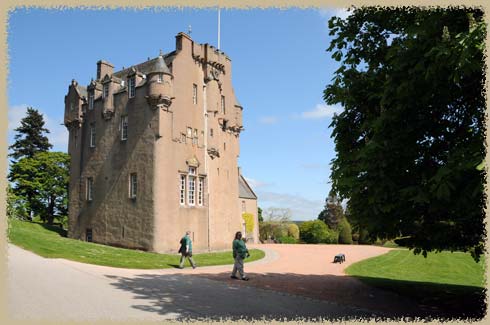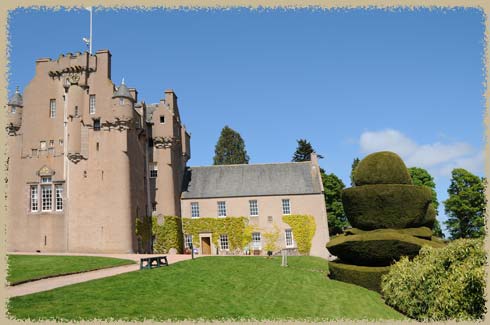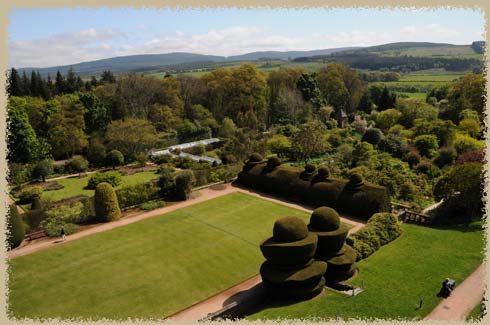Crathes Castle
In the course of a few days, we saw half a dozen castles that were obviously built off the same plan - tall, decorated, harled, the same color, the same feel: Crathes, Craigievar, Brodie, among others. When I asked if this castle was going to be reharled (after looking at buckets and water stains on the stairs), I was told "it's next on the list". Once again, the modern "fix" wasn't half as good as the original mason's work.

the original tower house - also awaiting re-harling
16th century tower house
Crathes is a not quite as tall as Craigiever (the castle it most looks like), standing only four storeys with an attic. It is basically square, with a small wing attached. The wind seems very small, but htat is because the connecting wall was made thicker to contain a staircase and chamber, so the wing projects only ten feet or so. The lower storeys ad quite plain, although with modern windows, and the upper storeys are decorated with turrets, bartizans and balustrades. Also like Craigeiever, the corners are rounded.
The ground floor of the castle, like nearly all tower houses, is vaulted for the kitchen and cellars (including a wine cellar. The first storey is the hall, with a large modern window inserted and beautiful painted ceilings. The castle has been 'modernized' several times (at least once with a fanficul faux-medieval castle feel, but many of the original elements remain, along with the art and antiques in the collection.
The entrance is in the re-entrant angle (again, this is very common, allowing the entrance to be defended from both the wing and the main tower), and it, too retains its iron gate. There are cellars in the tower, but the kitchen is in the wing. Also, like Craigievra, the upper floor is one long gallery across the main block and wing. Many of the upstairs rooms have painted ceilings, some only recently uncovered.
Other hidden features have been discovered during archaeological digs - a staircase discovered under the first floor, leading down the the kitchen, for example, and a variety of gunloops were harled over when the castle was maintained, and only recently discovered.

the relatively modern 2-story addition, replacing an 18th century wing
A wing was added in the 18th century. The current two-story addition is modern, though, replacing the original when it burned in 1966.
Much of the draw of the castle are the enormous grounds and gardens, which have a number of trails. The formal gardens are lovely. There are about 530 acres, including a four acre walled garden, and a croquet lawn. The topiary date from 1701, and are used as dividers between the carefully designed areas of the garden. For many, the gardens is the real draw here.
Ownership
The Burnetts owned the property here from the 14th century, although their original castle is gone (it is in the loch, buuilt on a crannog). The family was a favorite of Robert the Bruce, who gave them the lands as a gift in 1323.

looking from the gardens to the castle
Alexander Burnett, the 9th laird, started the castle in 1553, although it was not finished until 1596 by his namesake, Alexander, the 12th laird. The building was delayed several times by political upheavel during the reign of Mary, Queen of Scots (although she never did sleep here, at least it's not listed!)/. Alexnader is also the builder of nearby Muchalls castle, which was completed by his son.
The family was created baronets of Nova Scotia in 1626. The 15th laird added the three story wing in the 18th century. He died in 1714.
The castle was given to the national trust in 1951.

looking down from the tower to the lawns


